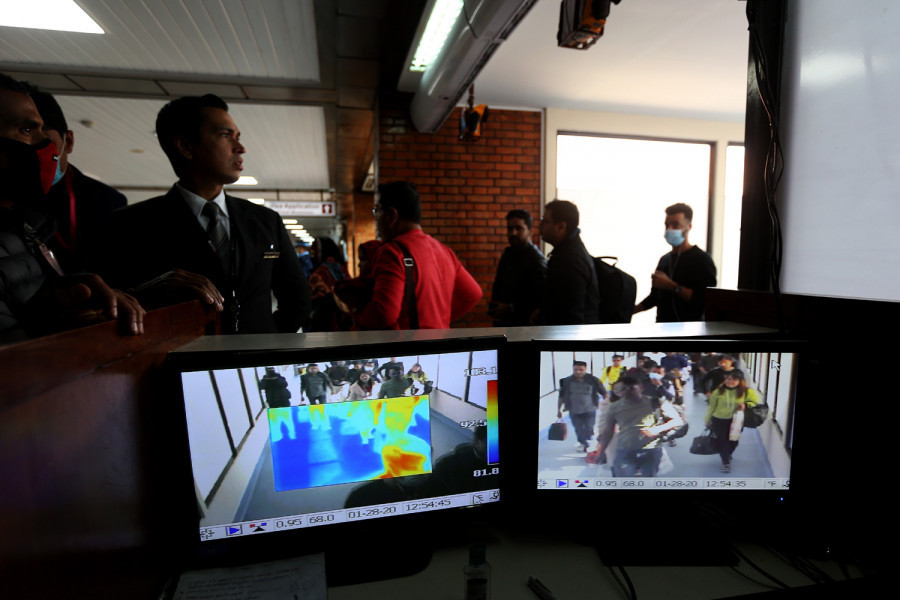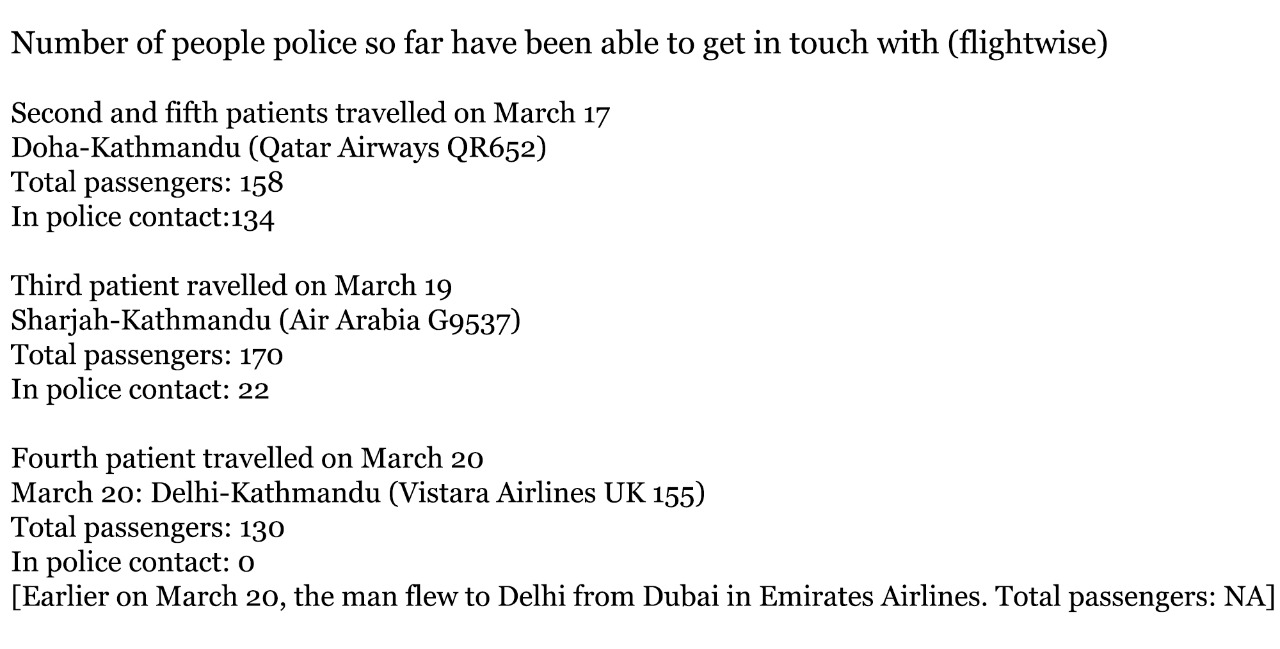National
Authorities face a hard time when it comes to contact tracing those who travelled with four Covid-19 patients
Of the 458 passengers who shared flights with four persons from Qatar, Sharjah and Delhi, 302 are still out contact.
Janakraj Sapkota & Arjun Poudel
Now that Nepal has reported fifth Covid-19 positive case—four live cases in all those recently travelled from countries like France, Belgium and the United Arab Emirates—authorities are staring at a hard time when it comes to contact tracing. The first Nepali who had tested positive for Covid-19 in January has already recovered.
Two women who travelled from France and Belgium used the same flight from Qatar on March 17. The plane carried 158 passengers. Then a 34-year-old man who tested positive for Covid-19 on Friday had flown from Dubai to Delhi and then to Kathmandu.
The man told the Post on Saturday that he took an Emirates flight to Delhi and then an Air Vistara flight to Kathmandu on March 20. The next day, he flew Buddha Air to reach Nepalgunj, from where he travelled on a public transport—a Toyota Hiace vehicle—to Attariya before reaching his home in Dhangadhi. It is not clear how many passengers were there in the Emirates flight. According to the authorities, there were 130 passengers in the Air Vistara flight to Kathmandu.
Doctors say contact tracing of people who came in contact with the so far Covid-19 cases is simply impossible with the existing human resources.
For instance, said Dr Gunaraj Awasthi, provincial health director at Sudurpaschim Province, the person from Dhangadhi who has tested positive may have come in contact with dozens of people while he travelled in Nepal—from Kathmandu to Nepalgunj and then from Nepalgunj to his hometown.
“We have just three people working at the Provincial Health Office and four in the Provincial Health Directorate,” Awasthi told the Post over the phone
Of the two students who came from France and Belgium via Qatar, one is in isolation at Sukraraj Tropical and Infectious Disease Hospital while the other one is in Baglung. The one from France is said to have exercised self-quarantine after reaching Kathmandu, while the one from Belgium had taken a flight to Pokhara from where she travelled on a jeep to reach Baglung.
Public health experts say the government approach has been too lackadaisical.
It’s not about the returnees just imposing self-quarantine when they reach home, it’s about who all they met and who all they came in contact with before reaching home, they say.
“The situation could be catastrophic if we fail to take immediate steps to trace the people and conduct tests on them,” said Dr Shyam Raj Upreti, public health expert.
Of those 458 passengers who travelled in different flights, according to authorities, only 156 have so far come in contact. The other 302 are still out of contact.
According to Senior Superintendent Umesh Raj Joshi, spokesperson for the Nepali Police, of the 158 passengers who came to Kathmandu on the March 17 Qatar Airways flight along with the second and fifth patients, only 134 have come in contact as of Sunday evening.
Those who have come in police contact are in isolation under the observation of local police or local level officials, said Joshi.
“The others are yet to come in police contact,” he added. “There are many whose passport address does not match with their actual address.”
The Air Arabia flight in which the third Covid-19 patient had travelled carried 170 passengers. Of them, only 22 have come in police contact, according to police.
And of the 155 passengers who were in the Air Vistara flight in which the fourth patient had travelled, police are yet to trace even a single one.
Police say now they also need to find out the number of passengers the domestic carriers carried, in which the fourth and fifth patients had travelled. That aside, they had used public vehicles also.
While all those who have tested positive so far are returnees from Europe and Gulf countries, thousands of Nepalis living and working in India have entered via land routes. There were no proper screenings. Nor were they quarantined.
Even if the government were to conduct tests, it neither knows how to do it nor has it the capacity to do it, according to health experts.
“Contact tracing of people in such a huge number is difficult but there is no other way,” said Upreti.
Dr Baburam Marasini, former director at the Epidemiology and Disease Control Division, said that the concerned agencies must work in a unified way, just like security agencies do in the time of emergency.
“This is one of the biggest emergencies faced by the world,” said Marasini. “We should not wait for separate directives. The government should activate all its health networks and take help from all other agencies.”
Police said their priority now is to trace down all those who took the international flights with the patients.
Joshi, the police spokesperson, said all those who travelled with the infected persons should display responsibility and get in touch with police. “They can also dial 100 and inform us about their health condition and address,” said Joshi. “We need assistance from the citizens’ level. If everyone relies solely on the police, it might take long to trace all these people.”





 5.55°C Kathmandu
5.55°C Kathmandu








%20(1).jpg&w=300&height=200)






